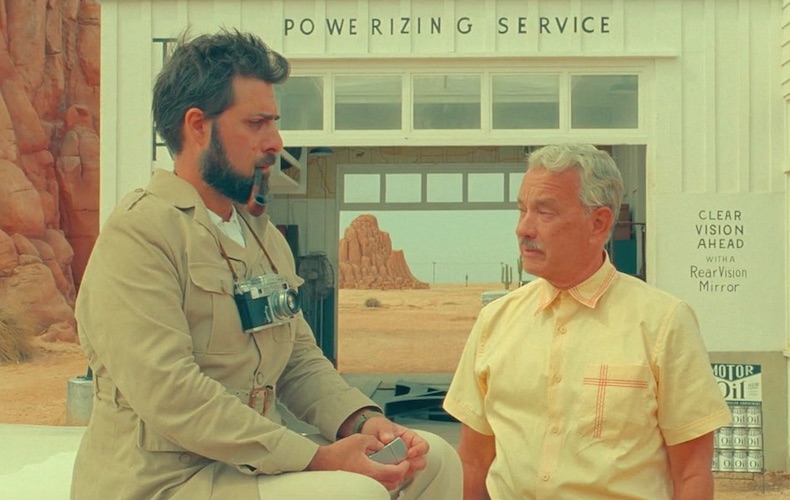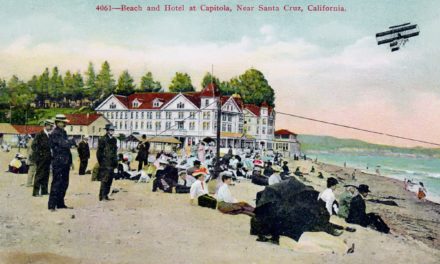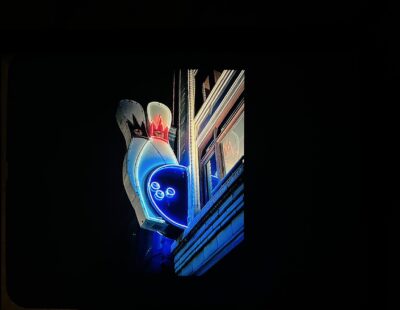
Midway through Asteroid City, Wes Anderson’s latest experiment in Brechtian distancing, a young girl is given a Rorschach test. Within every inkblot, she sees variations of the same thing. Detractors of Anderson’s work can undoubtedly relate to her; one of their main criticisms is that all of his films are more or less the same. The inclusion of the inkblot scene could be read as Anderson’s deliberate or unconscious embrace of that complaint. Yes, Asteroid City contains non-conformists struggling with personal issues, it takes place in a dollhouse version of reality, the compositions are symmetrical, and the humor is dry. But there’s been an evolution to Anderson’s filmmaking, and with Asteroid City, his inimitable directorial style has reached a whole new level of precision engineering.
Asteroid City tells the story of a fictitious stage play of the same name. It begins with a squarish black and white television broadcast reenacting the development of the production. Then, Oz-like, it opens up to a pastel-colored, conspicuously stagey desert tourist spot dubbed Asteroid City. There’s a solitary motel, gas station, and diner. Background cacti and mesas create a pop-up book effect. A lone billboard advertises the locale’s only claim to fame: the Arid Plains Meteorite. It’s 1955, and Asteroid City is hosting a government-sponsored junior stargazers convention. Among the first of many attendees to arrive are photojournalist Augie Steenbeck, played by Wes Anderson alumnus Jason Schwartzman, his genius son, Woodrow, played by Jake Ryan, who also appeared in Moonrise Kingdom, and Woodrow’s three younger sisters who like to indulge in Episcopalian Witchcraft, a religion of their own creation. Also in attendance are a self-absorbed, chronically depressed famous actress, Midge Campbell, and her brilliant daughter, Dinah, played by Wes Anderson newcomers Scarlett Johansson and Grace Edwards, respectively.
Augie is also depressed. He recently experienced a tragic turn of events that he’s withheld from his children. Coerced over the phone by his father-in-law, played by Tom Hanks, he finally shares the sad news; their mother, who had been ill, passed away weeks ago. Amidst burgeoning romances, a close encounter of the third kind, and a government-enforced lockdown, the prevailing theme is grief, a pet preoccupation of Anderson’s. But here, while deftly preserving the whimsical tone we’ve come to expect, his exploration of loss is more nuanced than ever before. However, his storytelling is getting increasingly conceptual, and Asteroid City’s frequent ping-ponging between layers of abstraction keeps us at an emotional arm’s-length. When Augie becomes overwhelmed with doubts about his performance, breaks character, abruptly exits to the backstage through a door in a fake mesa, and confronts the play’s director (portrayed by Adrien Brody), it’s all part of the reenactment. Or is it? Anderson’s storytelling occasionally strains under its contortions.
As with his previous film, The French Dispatch, Asteroid City is so meticulously realized, about the only thing distinguishing it from his animated films, Fantastic Mr. Fox and Isle of Dogs, are the live actors. And yet, under his direction, even they are being used more and more like adjustable figurines while delivering affectless line readings that come dangerously close to inducing uncanny valley spine-chills. But that’s the genius of Wes Anderson; every performance, camera movement, prop, and wardrobe decision reflect an astonishing degree of filmmaking mastery, imbuing Asteroid City with a purity of style that feels like an artistic zenith. It makes me wonder, where can he go from here? I can’t wait to find out.
For KSQD’s Film Gang, this is Paul Kanieski










